Site Conditions - what should happen
Technical Talk Series with Craig Thornhill, Technical Services Manager
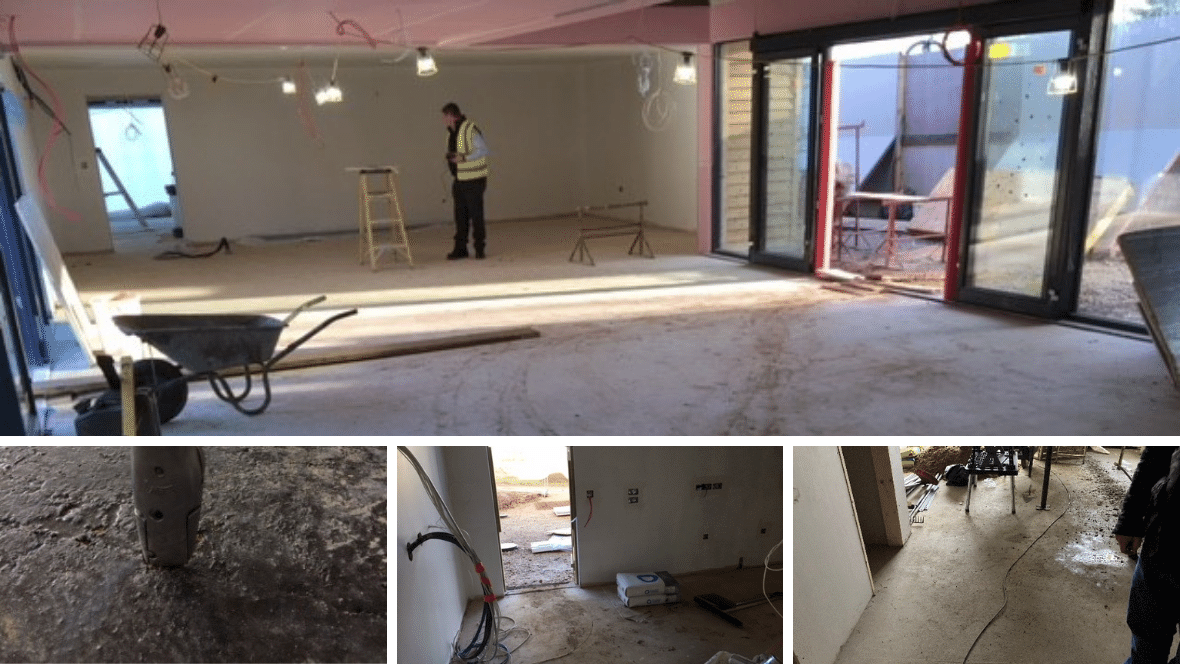
For this article, I have taken some existing guidance from the CFA Guide to Contract Flooring and extracts from relevant British Standards, as these pre-existing documents are readily available to view or purchase, and tried to add-in any other site condition related tips learned during my time in the industry. It is not an exhaustive list but hopefully will go some way in addressing and collating common issues and missed ‘best site practise’, faced by flooring contractors ahead of starting any fitting.
So, what should happen and what guidelines exist to assist the flooring trade?

It is a recognised fact that the appearance and performance of floorcoverings are determined to a large extent by the quality of the prepared base or screed on which they are laid. Whilst this might seem obvious, the sad fact is that ‘other trades’ can adversely affect these bases or screeds causing, in many cases, avoidable clearing up work or remedial actions to be carried out by the flooring contractor.
We know that those responsible for the design and construction of the subfloor must ensure that it meets the requirements for hardness, soundness, levels and surface regularities, dryness and other design parameters before flooring covering installation is commenced.
It should be equally clear that ‘those responsible’ should understand that the quality of the flooring installation also depends on attention being given to those other buildings products, work processes and the general conditions provided during flooring installation which may in any way be associated with, and therefore affect, the finished flooring. Any incompatibility with other trades or unsuitable conditions of work can restrict the ability of the floor layer to provide a neat, well adhered and satisfactory, lasting, floor finish.
An obvious initial ‘must have’ is that the building should be watertight and weatherproof before any flooring preparation or fitting commences with windows, doors and roof in place.
BS8203:2017 states that ‘Before starting to lay any floor coverings, any conflicting overhead work should be completed. The presence of underfloor heating and security systems should be checked and all preliminary work, such as the fixing of floor sockets for service plugs, completed. The base should be sound, smooth, clean and dry before laying commences.’
The problem of not receiving clear and clean work areas addresses the specific comment to CFJ. Each work area should be clear of all other trades and their materials to allow unhindered access for the floor layer. Any floor to be fitted must be clear of rubbish with any surface contamination removed as directed by the manufacturers of the next product to be applied. This includes plaster, filler, paint and firestop as mentioned in the comment. Ideally, these areas should be initially scraped to loosen adhered surface contamination before vacuuming prior to any flooring fitting work taking place.
Three British Standards, BS 5325 (textile), BS 8203 (resilient) and BS 8425 (laminates), advise that for the installation of flooring coverings, a steady work area temperature of between 18 and 27 degrees Celsius should be maintained throughout the period of the installation of the flooring.
For solid wood flooring (BS 8201), the temperature and humidity must be as close to the working temperature and humidity in which the floor will be used.
In all cases, the minimum subfloor surface temperature should be no less than 10 degrees Celsius.
These British Standards also advise that this work area temperature should be attained a minimum of 24 hours (ideally 48 hours) prior to the installation, so that flooring can be kept in the room and brought to room temperature (acclimatised) before installation.
It is equally important to maintain those temperatures for at least 24 hours after installation or until the adhesive has cured. This will mean that the heating will have to run continuously, not turned off after working hours.
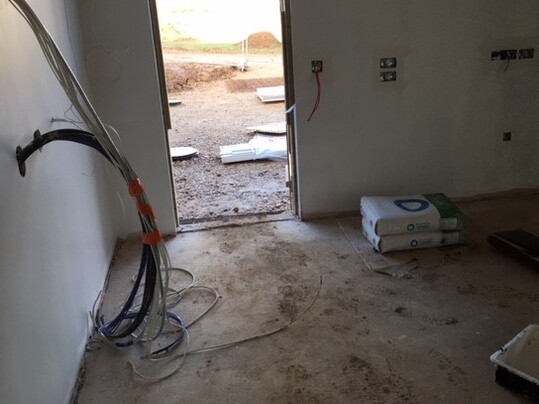
The building here is not watertight or weatherproof

Work space that is not clear or clean
It is also essential with most floorcoverings that they are laid in the same humidity conditions as would be expected to be prevalent in use. It is important to note that temporary heating equipment (typically gas type mobile heaters) which may be used to warm buildings to achieve the required temperature can also increase the humidity to a markedly higher level than would normally be expected. Also, turning off heaters at night in cold weather will lead to condensation as the air cools, causing water pooling on the surface of the floor.
The fitting of floorcoverings in a new building prior to the running of heating and/or de-humidification systems can affect long-term dimensional stability problems and must therefore be avoided.
Materials such as latex screeds and liquid damp proof membranes (DPM) are also susceptible to low temperatures, which can extend drying times, causing programming issues and possible product failure.
With fully flexible vinyls and linoleums, flexibility is important for a good and safe installation. At low temperatures these floorings will stiffen up making them difficult to apply and with rolls of floorings, difficult to unroll (with potential to crack) and achieve a satisfactory lay-flat condition.
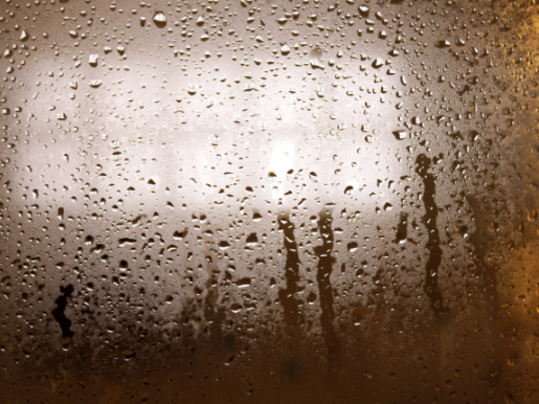
In all cases, provision should also be made for ventilation throughout and after installation to ensure a good air flow to allow fitments to dry. If required, the use of de-humidifiers should be considered to remove excess moisture.
If the building has underfloor heating (UFH), this should be switched off 48 hours prior to laying the floor coverings. As most adhesives which are used for floor laying do not achieve maximum bond strength immediately, the heating should not be turned on until at least 48 hours after laying and peak operating temperature should be avoided for a further seven days.
Note: When underfloor heating is switched off then an alternative source of heating will be required before, during and after the installation of the floor covering, until the UFH can be re-introduced, to maintain the required temperature level.
Note: When turning on the UFH, gradually increase the temperature over a number of days by only a few degrees per day until the desired room temperature is reached.
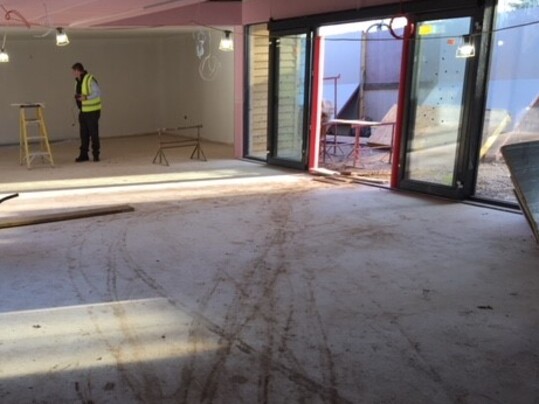
The provision of dry, clean, ventilated, waterproof, warm, weatherproof and secure site storage area is recommended. On multi-storey work, storage facilities should be available on each floor as the work proceeds, including special storage to be available for flammable adhesives and any other substances as may be required.
Note: Adequate provision for safe hoisting facilities and access to appropriate floor levels should be in place.
Importantly, a good standard of electric lighting for work areas, when required, should be readily available. Also, adequate and appropriate electric power sources to be in place for using power tools.

And last, but not least, it should be remembered that floor screeds are not wearing surfaces and as soon as possible after laying, should be protected against damage to the surface and contamination by other trades. Even foot traffic from other trades can cause considerable surface abrasion and contamination.
The consequent effects on the flooring application are numerous:
• Poor adhesion of the flooring over weak patches caused by wear of the screed surface.
• Weakly adhered aggregate can be pulled out when spreading the flooring adhesive resulting in small bumps appearing in the flooring after it has bedded down.
• Concrete and brickwork contractors working on the screed surface and failing adequately to clean off concrete and mortar residues, resulting in surface irregularity.
• Plaster and paint being dropped onto the screed contaminating the surface causing loss of adhesion and lifting of the flooring.
Note: Careful consideration must be given when using solvent-based products for removing paint, oil or other contaminants as residues can sit within the screed structure and affect the flooring installation.
Any areas of the screed surface damaged due to lack of protection or any other reason must be repaired before the flooring contractor commences work, although this cannot be accepted as an equal alternative to screed protection.
Over and above these, there are some practical things that a floor layer can do to avoid problems such as extremes of temperature affecting both floor and room. Extremes of temperature should be protected against, especially day and night temperatures. Where the ambient room temperature exceeds 27 °C and the high temperatures are caused by sunlight, particularly direct localised shafts of sunlight hitting the floor, shading should be used to limit the temperature increase. The floor covering and adhesive manufacturer(s) should be contacted for guidance on any specific instances of uncertainty.
In summary, the fact is that other trades are likely to have a limited appreciation of what is required for floor covering installation and probably work in their own little “bubble” preoccupied with their part in the building’s construction only and then pack up and leave. The residual detritus left from these trades can be ‘missed’ in the large scheme of things when working on busy multi-trade sites.
It is important therefore that clear contractual arrangements at the beginning of work commencing and effective communications between all parties before and during installation will minimise contention, optimise installation quality and maximise customer satisfaction. Whilst the need to provide the right conditions through specification is obviously of first importance, only by careful consideration being given to on-site quality control of these and other works, will the expected advantages be realised.
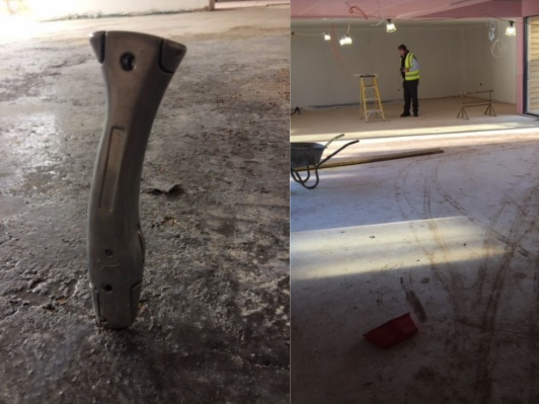
Screed Damage
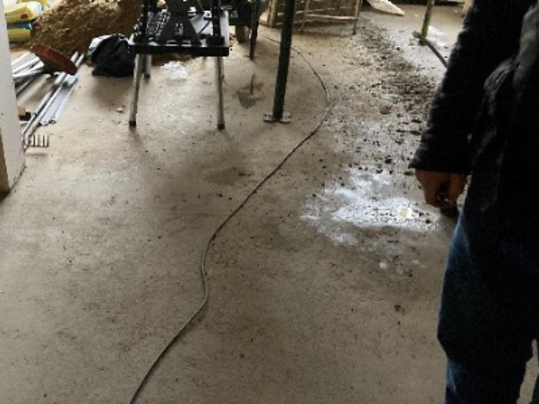
Contamination